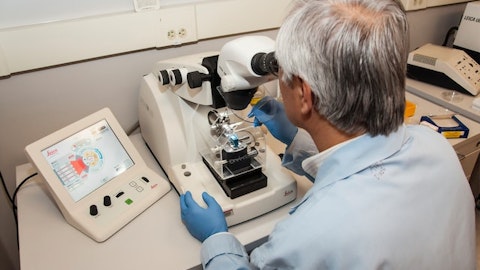Subbu Nambi: Perfect. Thank you, guys.
Paul Diaz: Thank you.
Operator: Thank you. Our next question comes from the line of Mason Carrico of Stephens Inc.
Jacob Krahenbuhl: Hey, this is Jacob on for Mason. Congrats on a strong start to the year. Lots have already been covered, so maybe just keep it to one here, but could you talk a bit about the early traction you’re seeing within your oncology portfolio after acquiring Intermountain? I realized launching Precise Liquid and your MRD offering will be a big driver of this opportunity, but have you may be seen an increase in the number of docs ordering multiple tests within this segment yet?
Paul Diaz: Yeah, I mean, I think that it’s still early this day here. I mean, the first thing was to make sure that we integrated it. Sam and the team are doing a great job there. And we’ve seen a slight increase, but the real push will happen later this year once it’s fully integrated and going into 2025. It’s not really envisioned to be a driver of our guide for this year. But we do see Precise Tumor numbers overall growing and not just in terms of the Intermountain for sure. And now we control 100% of P&L, so it’s not just sort of the allocated part of P&L. So that is starting to contribute. But I think what you’ll see coming out of ASCO is a big push in terms of our oncology team about preparing a Hereditary Cancer with Precise Tumor and that really sets the stage for Liquid next year and MRD.
So, stay tuned. I think we’ll have a lot to say at ASCO about how this portfolio comes together in terms of precision medicine tools for oncologists, particularly for breast cancer patients but for other indications as well. And that’s what we’ll be highlighting at ASCO. We’re pretty excited about the feedback we’ve gotten from oncologists in terms of that is reviewed our preparation.
Operator: Thank you. Our next question comes from the line of Michael Ryskin of BofA.
Paul Diaz: Hi, Mike.
John Kim: Good afternoon. This is John on for Mike. Hey, afternoon. I wanted to ask on gene sites, it’s great volume ASP and did better than our models so exceptionally well. Could you provide any update you’ve had in terms of improving the coverage? Like what states and blue plans are next for you? And, what’s in your guide versus what can be an upside?
Paul Diaz: It is – as Scott said, it’s just blocking and tackling right now. We haven’t even really fully levered biomarker pieces yet. We’re probably don’t want to call it individual states, but we are amping up a couple of states in the attorney general’s office and other places. But it’s been a number of different wins, $1 billion bucks here, $1 billion bucks there. All of a sudden you’re talking about a nice list in ASP. And just gaining more traction on coverage with large in terms of chain site and also improving prior off requirements. And we’re working with CMS, a Medicare Advantage plant with respect to prior off requirements, along with other industry participants. And again, as Scott said, it’s been across the board effort, across all our products in terms of seeking out places where we didn’t have coverage, even for MyRisk Hereditary Cancer, where we had certain blue plans that were not covering.
And as Scott said, last year was a really tough year from ASP’s perspective. And we’re seeing the result of that turnaround now, working through some of those coding changes and other things. We think, again, that momentum will continue. We’ll build on that throughout the year and going into as well.
John Kim: Got you. Understood. And then on the flip side, if I could ask for the tumor profiling, any thoughts on how the volume and the ASP is going to go there?
Paul Diaz: Yeah, the tumor profiling was an impact, because we had a really big win in Q1 last year with a couple of biopharma partners. So it was really in the biopharma revenue that skews that performance. My choice has been a little down, because it changed the average risk. But overall, that negative 17% was driven by the fact that we had a big win in Q1 of last year with two or three big biopharma partners. The biopharma business is very lumpy. So, we’re not really clear. We always get paid until it’s always really good business. But sometimes it falls in Q1, and sometimes it falls in Q3. And so we still are excited about the prospects of building that business, and that’s something Sam and Daneker [ph] are really partnering up on.
John Kim: Understood. All right. Thank you.
Paul Diaz: Thank you.
Operator: Thank you. I would now like to turn the conference back to Paul Diaz for closing remarks. Sir?
Paul Diaz: Thanks, everyone. I think everyone’s heard enough from me today. So, I appreciate you guys spending time in the call today. I just want to thank my teammates for all their hard work. It was actually a difficult operating quarter. We had a few issues in the lab that we had to work through, the team rally, and again, we’re just really pleased at the start of the year. I appreciate all of you participating in the call today in your support. And, again, I hope you are starting to see, as Scott said, just the beginning of the process here of us really starting to grow Myriad Genetics, and I think you can expect and should expect more from us as your request. So, thank you all.
Operator: This concludes today’s conference call. Thank you for participating. You may now disconnect.
Follow Myriad Genetics Inc (NASDAQ:MYGN)
Follow Myriad Genetics Inc (NASDAQ:MYGN)
Receive real-time insider trading and news alerts



